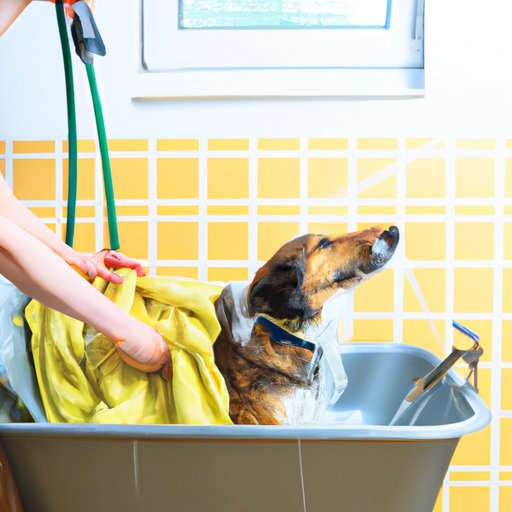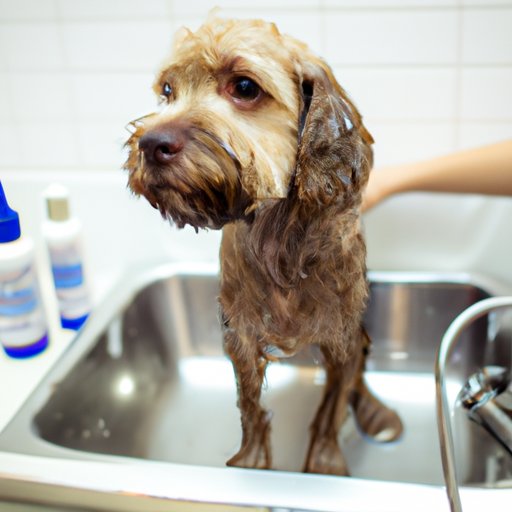Introduction
Surgery is a major medical procedure that requires special care and attention. Post-operative care is essential to ensure a successful recovery and prevent any potential complications. One important aspect of post-operative care is bathing a dog after surgery, as it helps to keep the wound area clean and free of infection. It is important to understand the right timing and steps to take before bathing a dog post-surgery in order to ensure a safe and successful bath.
Tips on Bathing a Dog After Surgery
Before bathing your dog after surgery, it is important to consult with a veterinarian to make sure it is safe to do so. Your veterinarian will provide specific instructions on when and how to bathe your dog post-surgery. It is also important to give your dog plenty of time to rest and heal before bathing them. Make sure your dog is comfortable and relaxed before beginning the bath.
How Soon Can You Give Your Dog a Bath After Surgery?
The timing for bathing a dog after surgery depends on several factors, such as the type of surgery performed and the size of the wound. Generally speaking, it is recommended to wait at least two weeks before bathing a dog after surgery. This allows enough time for the wound to heal and any stitches to dissolve.
What to Consider Before Bathing Your Dog Post-Surgery
It is important to check with your veterinarian to make sure it is safe to bathe your dog after surgery. Identify any potential risks associated with bathing your dog post-surgery and gather the necessary supplies to ensure a safe and successful bath. These supplies may include a mild shampoo, warm water, towels, and a thermometer to check the water temperature.
When is the Right Time to Bathe a Dog After Surgery?
When deciding when to bathe your dog after surgery, consider the type of surgery performed, the size of the wound, and the healing process. For minor surgeries, such as spaying or neutering, it is usually safe to bathe your dog two to three weeks after surgery. For more invasive procedures, such as orthopedic surgeries, it is recommended to wait at least four to six weeks before bathing your dog.
Steps to Take Before Bathing a Dog Post-Surgery
When bathing your dog post-surgery, it is important to take the necessary precautions to ensure a safe and successful bath. Prepare a safe space for your dog to bathe in and make sure the water temperature is just right. Gently clean and dry the wound area and use a mild shampoo and warm water. Avoid using soap or harsh detergents, which can irritate the wound area.

Understanding the Right Timing for Bathing a Dog After Surgery
It is important to follow the advice of your veterinarian when determining when to bathe your dog after surgery. Different types of surgeries require different timelines for bathing. For example, orthopedic surgeries may require a longer waiting period than spaying or neutering. Additionally, larger wounds may need more time to heal before a bath can be safely administered.
The Dos and Don’ts of Bathing a Dog After Surgery
When bathing a dog after surgery, there are certain dos and don’ts that you should keep in mind. Do use a mild shampoo and warm water, and don’t use soap or harsh detergents. Do keep an eye on your dog during the bath and don’t leave them unattended. Make sure to follow the instructions of your veterinarian and contact them immediately if you notice any unusual behavior or signs of discomfort.
Conclusion
Bathing a dog after surgery is an important aspect of post-operative care that can help to ensure a successful recovery. It is important to understand the right timing and steps to take before bathing a dog post-surgery. Consult with a veterinarian to make sure it is safe to bathe your dog and identify any potential risks associated with bathing your dog post-surgery. Follow the guidelines for when you can safely bathe your dog after surgery and remember to use a mild shampoo and warm water for a successful bath.
(Note: Is this article not meeting your expectations? Do you have knowledge or insights to share? Unlock new opportunities and expand your reach by joining our authors team. Click Registration to join us and share your expertise with our readers.)
